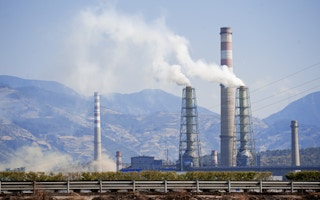Nine new emissions trading schemes (ETS) were launched worldwide in 2013, and as many as five of them were set up in various cities and provinces in China, according to a recent report released by the International Carbon Action Partnership (ICAP).
To continue reading, subscribe to Eco‑Business.
There's something for everyone. We offer a range of subscription plans.
- Access our stories and receive our Insights Weekly newsletter with the free EB Member plan.
- Unlock unlimited access to our content and archive with EB Circle.
- Publish your content with EB Premium.
This is the highest number of new schemes launched since the European Union began the world’s first carbon trading system in 2005.
The four other trading schemes which also started last year were in California in the United States, Switzerland, Kazakhstan and Quebec in Canada.
The Emissions Trading Worldwide: ICAP Status Report 2014, released on February 6, outlined the experiences of various governments which have been implementing ETS systems, and included a review of Europe’s current debate on backloading of carbon credits.
This refers to the EU government’s plan to limit the oversupply of carbon permits in the market as part of its effort to curb the decline of carbon prices after the region’s carbon market crashed during the economic crisis in 2008.
The European Commission has proposed to delay the sale of 900 million carbon credits to spur market activity.
The report also discussed the emergence of metropolitan and provincial-level trading schemes in Japan and China.
“
The global carbon market has not happened in a harmonised, top-down fashion as expected by policymakers and analysts in the 1990s and early 2000s. But rather, it is growing from a bottom up approach - ‘building on a multitude of systems that do not follow one blueprint, but have found different answers to questions like cap-setting, allocation, scope, and flexibility provisions’
The Lisbon-based entity, established for governments actively pursuing carbon markets, says it expects more trading schemes to come online by 2015 and that the share of global emissions covered by carbon trading is expected to rise by 70 per cent from its 2005 levels.
There are 13 mandatory carbon trading systems currently operating globally. ICAP said there are a further 15 governments at various levels which are considering the implementation of emission trading schemes to mitigate their emissions, including in China, Chile and Turkey.
Authors of the report noted that the global carbon market has not happened in a harmonised, top-down fashion as expected by policymakers and analysts in the 1990s and early 2000s.
But rather, it is growing from a bottom up approach - ‘building on a multitude of systems that do not follow one blueprint, but have found different answers to questions like cap-setting, allocation, scope, and flexibility provisions’.
The scope of such schemes as a policy instrument in implementing caps for GHG emissions has steadily increased due to the launch of new trading systems. Existing schemes also expanded their scope to include new industries or sectors.
However, ICAP observed that over time, regulators have reduced the cap or the maximum amount of emissions allowed in their trading schemes as they try to create incentives for organisations covered under the scheme to reduce their emissions.
China leads the region
ICAP said that the pilot schemes launched in China are a sign of policy innovation in a country more traditionally known for issuing bans and standards. The moves are seen as small steps that could lead to a national carbon trading system for the world’s largest greenhouse gas emitter.
The provinces of Chongqing and Hubei in China are expected to start their operations this year, while Hangzhou’s plans are currently being studied, the report said.
Chongqing province’s scheme has been reported to cover sectors such as production of electrolytic aluminum, ferro alloys, calcium carbide, cement, caustic soda, and iron and steel. The scheme may also allow participants to use forest-based offset credits to meet part of their targets.
In Hubei, the scheme is expected to cover around 150 of the most carbon intensive companies in the province that account for about 35 per cent of the province’s total carbon emissions.
Elsewhere in Asia, South Korea is expected to launch a national carbon trading system by 2015, and Japan and Thailand are reported to be still in the process of considering a similar national scheme.








